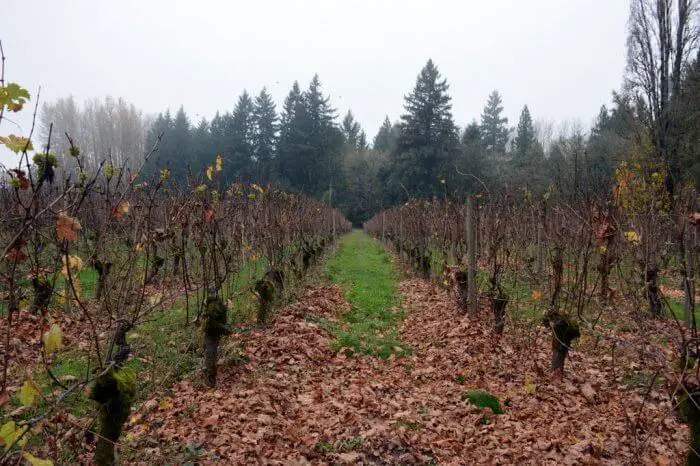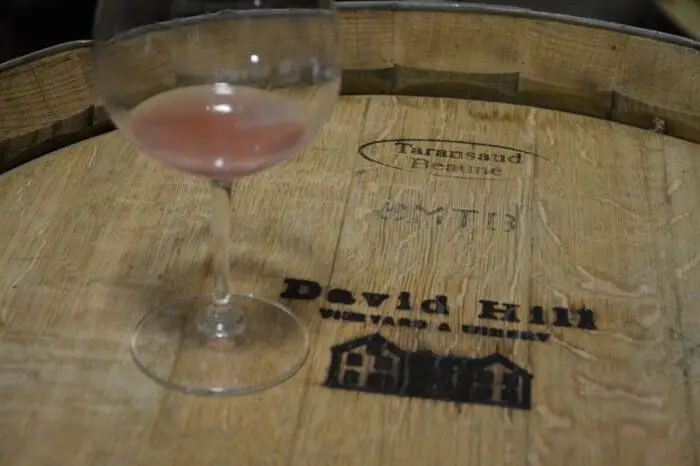This is what I know about grapes. Grapes grow on vines, flourish, and die. Sometimes, if they’re the lucky ones, they turn into wine. This process takes a full year–from the moment the buds break in springtime to when the leaves fall in autumn, there are millions and millions of grapes, all in Oregon’s Tualatin Valley, that go through this life cycle every year. Most start the process in their first year of life. It’s pretty predictable.
Most people come to the Tualatin Valley, a little place just outside of Portland in the wider Willamette Valley, to see these grapes in full form, when they’re plump and colorful. Most people want to stroll through these rows and rows of vines in summertime, when it’s sunny outside and the grapes are warm. I understand this–I get the allure of growth and newness and life. It’s what we expect to see when we think about wine regions. It’s what the wine writers at Wine Enthusiast had been thinking when they tasted the fruits of this new wine region’s labors and named the Willamette Valley “Wine Region of the Year” last year.
I’ll come back to see these vineyards in summer, of course, but this time, I wanted to see the grapes in winter, when the skies are grey and the vines tell a very different story. Wearing a coat and boots felt like exactly how I wanted to spend the weekend after the election that shook our nation, visibly, in ways I don’t think anyone–regardless of political affiliation–really expected.

I arrived in Portland on a chilly Thursday morning. Downtown, a crowd of people were preparing to protest against the election results for the third night in a row, and my shuttle driver talked at length about how far off the regular course we’d have to go to get to Hillsboro’s Orenco Station, the city center just outside of Portland where I’d be staying for the next three nights. Even under his frustrated tone, it was obvious how irritated and frustrated he was with the state of things. Across the country, people in other big cities were rallying too, crying out or celebrating. Things just seemed so….divided. Unpredictable. Uncertain. The other passenger in the car, a middle-aged Humanities professor at a community college outside Houston, Texas, chimed in that he was hopeful for change, an expression that suddenly seemed so empty to me. I sat quietly, watching Portland by night come into focus as we drove into the hills, and thought about the five vineyards I’d be visiting the next day.
The morning was a whirlwind, with stops at Hamacher Wines, Raptor Ridge Winery, and Sake One, the first American owned and operated sake brewer in the world. At each stop, I’d met the owners, talked excitedly about the pinot noirs that make Oregon wine so special, and tasted everything from pinot gris to chardonnay to malbec.

By the time we got to our last stop of the day–David Hill Vineyard–the sun was starting to fall below the concave horizon line of the rolling hills.
*
The grapevines at David Hill Winery are thick, wiry, and hearty. The older plantings–among them pinot noir, pinor blanc, and muscato–have been going through their life cycle, each year, for fifty long years. They are some of the oldest pinor noir vines in all the Willamette Valley. Some of them are huge, gnarled, winding around the wires that connect them like knotted rope. The older plants’ roots bury deep into the laurelwood soil, grasping onto the basalt layers and drawing their nutrients from the rich Oregonian soil. The newer plants–the pinot gris, the chardonnay, and the dijon–provide a young and less refined presence to the more mature ones. As we talk to the new manager, we taste some of the fresh wine, both newly made, and classic reserve. We even get to taste some of the wine as it is fermenting in the barrels. What will eventually become a rose is now a soft rosy pink.

Before we left, I asked if I could wind through the rows of naked vines and take some photos. In my experience, there are never enough photos of vineyards in winter–so many of the photos we see are of vineyards right before harvest, when the summer sun casts long shadows and the vines are brimming with ripe grapes. As I crept through the rows and rows of dormant vines, though, looking for the kinds of shots I wanted to take, I realized that many of the vines weren’t naked at all. Some of them had bunches of green and purple grapes left behind, clustered around the tips of the branches and nestled into the folds of the vines’ creases. I touched one–it felt cold, hard. I wondered why there were still grapes left on these branches, when harvest had long happened and the grapes that had been picked were now fermenting into what would become the 2016 batch of wines at the vineyard.

As I crossed back over to David Hill’s tasting room, camera in hand, it occurred to me that I felt comforted by the life cycle–and these little bunches of leftover grapes. There are no secrets with fruits like these–the buds blossom, the grapes grow, and wine gets made. Its temperament changes with the seasons. Its flavors tell us everything we need to know about the soil, the rain, the sun, and the wind. It is, in a word, both delicately predictable–given most conditions, the life cycle will do what we expect it to do–and at the same time, wildly petulant, a fruit made into wine that no one–not even the wine maker–can always predict.
—
Story and photographs by Kristin Winet.
A very special thanks to Sylke and Jackie at the Tualatin Valley tourism board for hosting my visit to Oregon. If you’re interested in a trip to Oregon’s wine region, they have lots of fun itineraries and ideas on their website!
